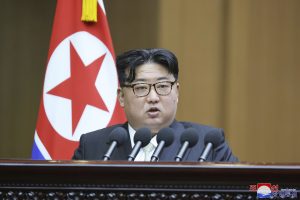The status quo in inter-Korean relations is a disaster in the making. Seoul and Washington must do what they can to improve relations with Pyongyang. The alternative is to do nothing and drift into an even more serious crisis as North Korea further builds up its nuclear and missile capabilities.
The current situation is that Kim Jong Un and Yoon Suk-yeol, the leaders of North Korea and South Korea, respectively, are locked in a cycle of dangerous, confrontational saber-rattling. Although it seems unlikely that Kim wants to start an all-out war, the risk is that he may engage in some form of military provocation against the South, and that such adventurism may lead to an unintended escalation into a much wider conflict.
One reason Kim may feel emboldened to take such risk is the broader global geopolitical environment, which now features a Cold War-like standoff in the Korean Peninsula between South Korea, the United States, and Japan on the one hand, and North Korea, China, and Russia on the other. As Beijing and Moscow are now more closely aligned with Pyongyang, Kim may feel that he has more room for taking risks vis-à-vis Seoul and Washington.
Meanwhile, Yoon has declared that North Korean military provocations will be met with a retaliation multiple times more severe. The danger is that Kim’s adventurism and Yoon’s hardline response will lead to escalation, spelling a catastrophe for the region and for the world.
Given the stakes involved, what can Seoul and Washington do to lower tensions with Pyongyang?
South Korea can begin by offering a response to the claims made by Kim Jong Un in his recent statements. At the Workers’ Party Plenum on December 30, 2023, Kim declared that Pyongyang is not interested in reconciliation or reunification with South Korea because Seoul has proclaimed North Korea as its main enemy and is seeking to topple North Korea’s regime and reunify Korea by absorbing North Korea. Yoon can issue a statement reassuring Pyongyang that Seoul wants peace – not war – with North Korea. This can be done in a public statement he makes or can be conveyed to Pyongyang through diplomatic channels.
To show that South Korea is not seeking to topple Kim, Seoul can offer to refrain from activities aimed at undermining the North Korean regime, such as the loud speakers in the DMZ blaring anti-regime propaganda.
Importantly, Seoul can offer to refrain from sending balloons containing propagandistic leaflets into North Korea. This is important because, apparently, one major reason why inter-Korean relations quickly deteriorated after the whirlwind of summitry in 2018-2019 is that some South Korean NGOs continued to send such balloons into North Korea despite warming relations. Pyongyang’s rulers took offense at this, protesting to Seoul that this amounted to a devious attempt to topple the North Korean government while outwardly professing peace.
While it is true that South Korea’s democracy allows freedom of expression of its citizens and the government cannot – and should not – control the actions of NGOs, there are things that Seoul can do to work with NGOs and dissuade them from taking actions that raise inter-Korean tensions and threaten world peace.
Seoul can further demonstrate its desire for peace by offering economic incentives for Pyongyang to pursue peace instead of further militarization. Yoon offered glimpses of such incentives in his presidential inauguration speech in 2022, saying that South Korea can help North Korea economically if the latter pursues denuclearization. Yoon can issue a statement saying the offer is still on the table, this time offering more concrete details of such economic aid to Pyongyang.
This last point ties in with what the United States can do to reduce tensions with North Korea. Washington needs to engage Pyongyang in talks, and the way to induce Kim Jong Un to come to the negotiating table is by offering talks with no preconditions. The past approach of insisting on CVID (complete, verifiable, irreversible denuclearization) from the outset of negotiations is a non-starter for Pyongyang.
Instead, the United States needs to be patient and willing to go through a step-by-step gradual process of building mutual trust leading to arms reduction. Washington can work with allies including Seoul to offer Pyongyang economic incentives tied to the reaching of specific milestones in arms reduction. Such a pathway offers the only realistic chance for curbing (or at least slowing down) North Korea’s rapid arms build-up.
Some may object, saying all this is naïve and will gain no traction with the authorities in Seoul, Washington, and Pyongyang. But the alternative is to let relations deteriorate even further and just watch tensions rise even more as North Korea further builds up its nuclear and missile stockpile with each passing day. Efforts to improve relations with Pyongyang, even if they do not yield immediate results, can still lower tensions and, even for that reason alone, should be tried.

































